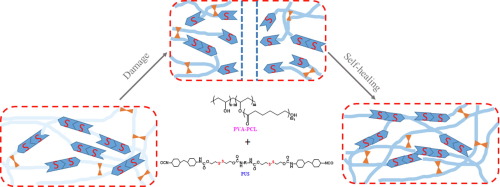当前位置:
X-MOL 学术
›
Eur. Polym. J.
›
论文详情
Our official English website, www.x-mol.net, welcomes your
feedback! (Note: you will need to create a separate account there.)
A high stiffness and self-healable polyurethane based on disulfide bonds and hydrogen bonding
European Polymer Journal ( IF 5.8 ) Pub Date : 2020-02-01 , DOI: 10.1016/j.eurpolymj.2020.109475 Maochen Liu , Jiang Zhong , Zijian Li , Jinchuang Rong , Kun Yang , Jiyong Zhou , Liang Shen , Fei Gao , Xuelong Huang , Haifeng He
European Polymer Journal ( IF 5.8 ) Pub Date : 2020-02-01 , DOI: 10.1016/j.eurpolymj.2020.109475 Maochen Liu , Jiang Zhong , Zijian Li , Jinchuang Rong , Kun Yang , Jiyong Zhou , Liang Shen , Fei Gao , Xuelong Huang , Haifeng He

|
Abstract Despite lots of strategies involving extrinsic and intrinsic solutions to self-healing materials, it remains a challenge to achieve a self-healable material with excellent mechanical properties. Here, we describe the use of poly(vinyl alcohol)-graft-(e-caprolactone) cured isocyanate-terminated disulfide-containing polyurethane to tune the strength and self-healing efficiencies. The results of solvent swelling experiments and Fourier transform infrared spectrometer indicate crosslinking structure and numerous hydrogen bonds in our synthetic polymers. The strong hydrogen bonding interactions and appropriate crosslinked networks provide good tensile mechanical performance. Meanwhile, the dynamic disulfide bonds and hydrogen bonds in this system also enjoyably contribute to the self-healable behavior at a moderate temperature. The self-healing polyurethane displays a maximum Young’s moduli of 112 MPa, a toughness value of 81 MJ/m3, which are quite remarkable compared to the previous reports. The self-repairing efficiency is impressively as high as 94%. Moreover, this material also exhibits an attractive reprocessing ability.
中文翻译:

基于二硫键和氢键的高刚度和自修复聚氨酯
摘要 尽管有许多涉及自修复材料的外在和内在解决方案的策略,但实现具有优异机械性能的自修复材料仍然是一个挑战。在这里,我们描述了使用聚(乙烯醇)-接枝-(ε-己内酯)固化的异氰酸酯封端的含二硫化物的聚氨酯来调整强度和自愈效率。溶剂溶胀实验和傅里叶变换红外光谱仪的结果表明我们的合成聚合物中存在交联结构和大量氢键。强氢键相互作用和适当的交联网络提供了良好的拉伸机械性能。同时,该系统中的动态二硫键和氢键也有助于在中等温度下的自修复行为。自修复聚氨酯的最大杨氏模量为 112 MPa,韧性值为 81 MJ/m3,与之前的报道相比,这是非常了不起的。自修复效率高达 94%,令人印象深刻。此外,这种材料还表现出有吸引力的再加工能力。
更新日期:2020-02-01
中文翻译:

基于二硫键和氢键的高刚度和自修复聚氨酯
摘要 尽管有许多涉及自修复材料的外在和内在解决方案的策略,但实现具有优异机械性能的自修复材料仍然是一个挑战。在这里,我们描述了使用聚(乙烯醇)-接枝-(ε-己内酯)固化的异氰酸酯封端的含二硫化物的聚氨酯来调整强度和自愈效率。溶剂溶胀实验和傅里叶变换红外光谱仪的结果表明我们的合成聚合物中存在交联结构和大量氢键。强氢键相互作用和适当的交联网络提供了良好的拉伸机械性能。同时,该系统中的动态二硫键和氢键也有助于在中等温度下的自修复行为。自修复聚氨酯的最大杨氏模量为 112 MPa,韧性值为 81 MJ/m3,与之前的报道相比,这是非常了不起的。自修复效率高达 94%,令人印象深刻。此外,这种材料还表现出有吸引力的再加工能力。











































 京公网安备 11010802027423号
京公网安备 11010802027423号